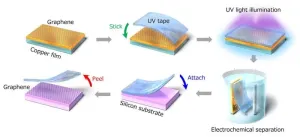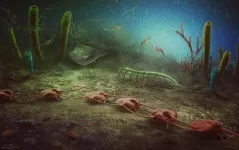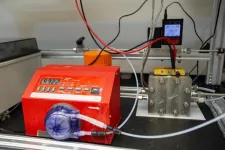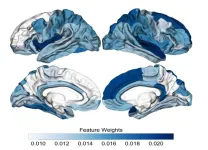Fukuoka, Japan – Materials just atoms in thickness, known as two-dimensional (2D) materials, are set to revolutionize future technology, including in the electronics industry. However, commercialization of devices that contain 2D materials has faced challenges due to the difficulty in transferring these extremely thin materials from where they are made onto the device.
Now, a research team from Kyushu University, in collaboration with Japanese company Nitto Denko, have developed a tape that can be used to stick 2D materials to many different surfaces, in an easy and user-friendly way. Their findings were published in Nature Electronics on February 9, 2024.
“Transferring 2D materials is typically a very technical and complex process; the material can easily tear, or become contaminated, which significantly degrades its unique properties,” says lead author, Professor Hiroki Ago of Kyushu University's Global Innovation Center. “Our tape offers a quick and simple alternative, and reduces damage.”
The researchers began by focusing on graphene. Made from a thin sheet of carbon atoms, graphene is tough, flexible, and light, with high thermal and electrical conductivity. Dubbed a “wonder material” upon discovery, it has potential applications in biosensing, anti-cancer drug delivery, aeronautics and electronic devices.
“One of the main methods of making graphene is through chemical vapor deposition, where graphene is grown on copper film. But to perform properly, the graphene must be separated from the copper and transferred onto an insulating substrate, like silicon,” Professor Ago explains. “To do this, a protective polymer is placed over the graphene, and the copper is then removed using etching solution, such as acid. Once attached to the new substrate, the protective polymer layer is then dissolved with a solvent. This process is costly, time-consuming and can cause defects to the graphene’s surface or leave traces of the polymer behind.”
Professor Ago and his colleagues therefore aimed to provide an alternative way of transferring graphene. They used AI to develop a specialized polymer tape, dubbed “UV tape”, which changes its attraction to graphene when irradiated with UV light.
Before exposure to UV light, the tape has a strong adhesion to graphene, allowing it to “stick”. But after UV exposure, the atom bonding changes, which decreases the level of adhesion to graphene by about 10%. The UV tape also becomes slightly stiffer and easier to peel off. Taken together, these changes allow the tape to be peeled off the device substrate while leaving the graphene behind.
The researchers also developed tapes that can transfer two other 2D materials: white graphene (hBN), an insulator that can act as a protective layer when stacking 2D materials, and transition metal dichalcogenides (TMDs), a promising material for the next generation of semiconductors.
Importantly, when the researchers looked closely at the surface of the 2D materials after transfer, they saw a smoother surface with fewer defects than when transferred using the current conventional technique. Upon testing the materials’ properties, they also found that they were more efficient.
Transfer using UV tape also offers numerous other advantages over current transfer techniques. Because the UV tape is bendy, and the transfer process doesn’t require the use of plastic-dissolving solvents, flexible plastics can be used as the substrate of the device, expanding potential applications.
“For example, we made a plastic device that uses graphene as a terahertz sensor. Like X-rays, terahertz radiation can pass through objects that light can’t, but doesn’t damage the body,” Professor Ago says. “It’s very promising for medical imaging or airport security.”
What’s more, the UV tape can be cut to size so that only the exact amount of 2D material needed is transferred, minimizing waste and reducing cost. 2D layers of different materials can also be easily laid on top of each other in different orientations, allowing researchers to explore new emerging properties from the stacked materials.
For their next steps, the researchers are aiming to expand the size of the UV tape to the scale needed for manufacturers. Currently, the largest wafer of graphene that can be transferred is 10 cm in diameter. Professor Ago and his colleagues are also trying to resolve the problem of wrinkles and bubbles that form on tape, causing small defects.
The research team also hope to improve stability, so that 2D materials can be attached to UV tapes for a longer period of time, and distributed to end users, such as other scientists.
“The end users can then transfer the material onto their desired substrate by applying and removing the UV tape like a child’s sticker, with no training needed,” says Professor Ago. “Such an easy method could fundamentally change the style of research and accelerate the commercial development of 2D materials.”
###
For more information about this research, see "'Ready-to-transfer two-dimensional materials using tunable adhesive force tapes" Maki Nakatani, Satoru Fukamachi, Pablo Solís-Fernández, Satoshi Honda, Kenji Kawahara, Yuta Tsuji, Yosuke Sumiya, Mai Kuroki, Kou Li7, Qiunan Liu, Yung-Chang Lin, Aika Uchida, Shun Oyama, Hyun Goo Ji4, Kenichi Okada, Kazu Suenaga, Yukio Kawano, Kazunari Yoshizawa, Atsushi Yasui & Hiroki Ago, Nature Electronics, https://doi.org/10.1038/s41928-024-01121-3
About Kyushu University
Founded in 1911, Kyushu University is one of Japan's leading research-oriented institutes of higher education, consistently ranking as one of the top ten Japanese universities in the Times Higher Education World University Rankings and the QS World Rankings. The university is one of the seven national universities in Japan, located in Fukuoka, on the island of Kyushu—the most southwestern of Japan’s four main islands with a population and land size slightly larger than Belgium. Kyushu U’s multiple campuses—home to around 19,000 students and 8000 faculty and staff—are located around Fukuoka City, a coastal metropolis that is frequently ranked among the world's most livable cities and historically known as Japan's gateway to Asia. Through its VISION 2030, Kyushu U will “drive social change with integrative knowledge.” By fusing the spectrum of knowledge, from the humanities and arts to engineering and medical sciences, Kyushu U will strengthen its research in the key areas of decarbonization, medicine and health, and environment and food, to tackle society’s most pressing issues.
END









